by Dr. Anand Titus and Geeta N. Pereira
The true biologist deals with life,
with teeming, boisterous life, and
Learns something from it,
Learns that the first rule of life is living.
JOHN STEINBECK
To date we have written a dozen or more articles on the pro active role of microorganisms in shaping the destiny of the Coffee Mountain. However, off late we have received hundreds of e. mail requests from all over the globe, asking us to elaborate on the type of microorganisms carrying out these functions. Armed With a back ground of Microbiology and Horticulture, we have made an honest attempt to simplify the role of BACTERIA in coffee plantation ecology.

All living organisms are classified as either PROKARYOTIC (PRIMITIVE) or EUKARYOTIC (Higher forms of life) based on their cellular structure. Bacteria and blue green algae are grouped under prokaryotes and all other organisms are eukaryotes. Bacteria are unicellular microscopic or single celled organisms widely distributed in nature. The greatest benefit in studying bacteria is that it throws light on the evolution of simple cellular systems and the higher forms of life.
Microorganisms are categorized into six distinct groups.
- BACTERIA
- FUNGI
- ACTINOMYCETES
- ALGAE
- PROTOZOA
- VIRUSES
The primary purpose of writing this article is to help coffee farmers worldwide in understanding the basic premise on which BACTERIA operate and the ways and means of carefully exploiting their potential to maintain a perfect ecological balance within the coffee farm.
The coffee habitat provides a fertile ground generating a host of both macro and micro organisms. The bacteria are the most dominant group of microorganisms in coffee soils. The microscopic analysis of coffee soils shows that there is plenty of room at the bottom for the proliferation of different types of microorganisms because of the rich humus and organic matter content.
Among the different groups, bacteria are capable of harvesting atmospheric nitrogen, solubilisation of rock phosphate and in the transformations of various substrates resulting in periodic supply of available nutrients for plant growth and development. However, coffee farmers need to understand that the types of bacteria and their numbers are governed by the soil type and cultivation practices like addition of chemical manures, pesticides, poisons, type of tillage etc. In turn the activity of bacteria is influenced by the availability of nutrients, both in organic and inorganic forms.
Their numbers are very high in coffee soils with large number of trees compared to open meadows. This is due to the shading nature as well as greater root density and the abundant availability of soil organic matter. Due to the high organic matter content of coffee soils, bacteria decompose the organic matter and in the process acquire energy.

Bacterial cells are so very small that when you think of these fastidious and ubiquitous microbes, you need to think small. They are measured in microns and the equivalent of one micron is: one by thousandth of a millimeter. Hence one needs a fairly high powered microscope to observe these minute wonders. However, they have a remarkable advantage because they have their strength in numbers.
The population of bacterial cells in soils is always great. Due to their rapid growth and short generation time they can quickly act on various organic materials. In harsh environments lacking oxygen the bacteria alone are responsible for almost all the biological and chemical changes. Because of their very small size bacteria have a very high ratio of surface area to volume. Also, since bacteria are single celled microorganisms they absorb their nutrients through their cell membrane, there by exhibiting very high metabolic rates.
The earliest inhabitants of Planet Earth have undoubtedly been the microorganisms. From primitive prokaryotic unicellular microorganisms, evolved the higher forms of life. Microorganisms have thus been the earliest participants in shaping various life processes. Microorganisms have been largely responsible in changing the primordial atmosphere resulting in the formation of gaseous oxygen needed for plant growth.
Fifteen million years of evolution has shaped the coffee forest and today their future is in our hands. Fundamentally, it has been an evolution of skills. The evolutionary ladder points out to the pivotal role played by microorganisms in adapting to harsh environmental conditions, formation of tripartite bonds, break down of complex polysaccharides into simpler molecules and in the process providing the energy needs of the biotic community. It is in this context that this article throws light on the role of microorganisms, starting with BACTERIA in transforming the coffee landscape into an evergreen rich forest. Among the different microorganisms, Bacteria are known to play a vital role in the distribution and supply of energy needs of the entire coffee mountain. Decomposition of almost all insoluble salts is mediated by one or the other group of bacterial communities.
DISTRIBUTION AND FUNCTIONS OF BACTERIA
Bacteria are widely distributed along the length and breadth of the coffee mountain. In short they are found almost every where. Bacteria are single celled organisms and in spite of their simplicity are highly efficient. Their numbers decline with depth of soil.
A majority of the coffee farmers are unaware that the great majority of bacteria are beneficial and absolutely necessary to convert farm wastes, organic debris and other by products into energy rich compounds needed for plant growth and development. Plants and animals depend on the fertility status of the soil and this in turn is dependent on the activity of soil microorganisms. Plants cannot directly utilize organic compounds such as fatty acids, lipids, carbohydrates and proteins. Microorganisms are a vital link in the mineralization of organic constituents and provide nutrients in the available form for plant growth and development.
Bacterial cells can withstand long periods of drought due to the protective cover around the cell wall known as CAPSULE. The capsule is a slimy or a gelatinous material and encloses either one cell or a group of cells. At times the bacteria make use of the polysaccharides present in the capsule as a source of reserve food material. The capsule enables the bacteria to avoid predation by larger soil microbes and infection from viral strains. In addition to protection, capsules also play an important role in the attachment of bacterial cells to plant or rock surfaces and in the formation of biofilms.
Bacteria are morphologically grouped into three types. Cell structure is a key element in the characterization of bacteria.
- Cylindrical or Rod shaped commonly referred to as Bacilli. They are the most numerous. Bacillus species are known to overcome extreme weather conditions by the formation of endospores that function as part of the normal life cycle of the bacterium. These endospores are resistant to long periods of drought and desiccation. With the on set of favorable conditions the spore germinates and a new bacterial cell grows.
- Communication between all life is essential in unfolding the various patterns of life. Without the ability to communicate, life, including the simplest single celled organism, could not exist. Bacteria have the capacity to analyze vibrations in the surroundings and accordingly react. Besides shape and size certain rod shaped bacteria have thin hair like appendages on the outer cell wall known as flagella, which can sense the external environment and constantly send out chemical signals to reach out to other communities. Flagella are believed to be organs of locomotion.
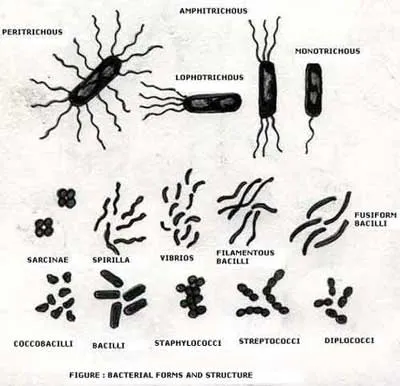
The number and place of attachment vary. When a single flagellum is attached to one end of the rod it is known as MONOTRICHOUS. If the flagella are attached singly at both ends it is known as AMPHITRICHOUS ; If more than one flagellum or a bunch of them are attached to either one end or both the ends it is known as LOPHOTRICHOUS and if the flagella are covered all over the cell it is known as PERITRICHOUS. - Spherical or ellipsoidal bacteria are called cocci. Ellipsoidal bacteria occur in pairs and are referred to as STREPTOCOCCI, when in four cells, arranged in a square they are known as TETRADS; when in irregular clusters like a bunch of grapes they are called STAPHYLOCOCCI and when arranged in a cubical form known as SARCINAE.
- Spiral or helicoidal.
Winogradsky a leading soil microbiologist placed Soil bacteria into two broad divisions.
- AUTOCHTHONOUS SPECIES:
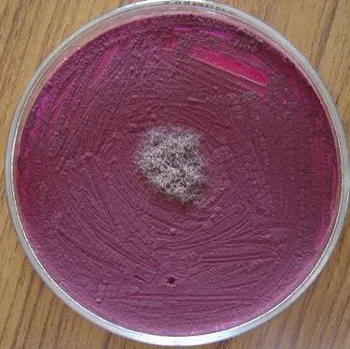 These refer to the indigenous or native species. The population of these bacteria is always uniform and constant in coffee soils because their nutrition is dependent on the native soil organic matter. They multiply rapidly in the presence of large quantities of biomass, organic matter, humus, and other soil amendments having a low C:N ratio. They are pretty tough and resistant to varied agro climatic conditions. They participate in all biochemical functions of the community. The presence of these bacteria is fairly high and their numbers are constant. The presence or absence of specific nutrients does not change their numbers significantly.
These refer to the indigenous or native species. The population of these bacteria is always uniform and constant in coffee soils because their nutrition is dependent on the native soil organic matter. They multiply rapidly in the presence of large quantities of biomass, organic matter, humus, and other soil amendments having a low C:N ratio. They are pretty tough and resistant to varied agro climatic conditions. They participate in all biochemical functions of the community. The presence of these bacteria is fairly high and their numbers are constant. The presence or absence of specific nutrients does not change their numbers significantly. - ALLOCHTHONOUS SPECIES OR ZYMOGENOUS BACTERIA OR FERMENTATIVE:
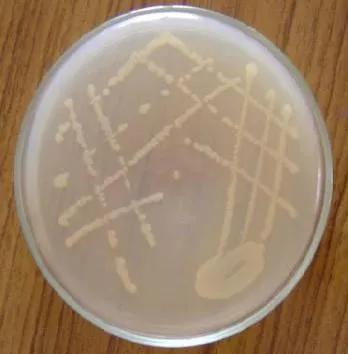 Commonly referred to as the invaders. Their participation in biochemical functions is insignificant. These bacteria are active fomenters and need nutrients which are quickly exhausted. They are involved in a process in which organic matter is rapidly attacked in successive stages and made available to the plants. At each stage of decomposition a specific group of organism is involved. The bacterial numbers increase rapidly whenever furnished with the special nutrients (leaf litter, biomass, compost) to which they are adapted. On exhaustion of these nutrients their numbers decrease and return with the addition of nutrients. Hence, this group of bacteria requires an external source of energy for their multiplication and growth.
Commonly referred to as the invaders. Their participation in biochemical functions is insignificant. These bacteria are active fomenters and need nutrients which are quickly exhausted. They are involved in a process in which organic matter is rapidly attacked in successive stages and made available to the plants. At each stage of decomposition a specific group of organism is involved. The bacterial numbers increase rapidly whenever furnished with the special nutrients (leaf litter, biomass, compost) to which they are adapted. On exhaustion of these nutrients their numbers decrease and return with the addition of nutrients. Hence, this group of bacteria requires an external source of energy for their multiplication and growth.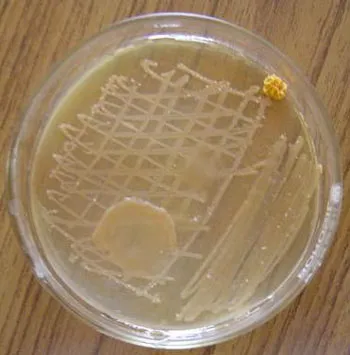
Bacteria in this group include the nitrogen fixers, phosphorus solubilisers, nitrifiers, cellulose hydrolyzing bacteria, sulphur oxidizers, spore forming bacillus and non spore forming pseudomonas.
ENVIRONMENTAL FACTORS
Bacterial numbers, their density, type and composition is governed by the environmental Stimulus. The important factors are listed below.
- AERATION :
Bacteria are further divided as
AEROBES: Require the presence of oxygen for growth and metabolic activity.
ANAEROBES: Bacteria which grow in the absence of oxygen.
FACULTATIVE ANAEROBES: Develop either in the presence or absence of oxygen.
AEROTOLERANT ANAEROBES: These bacteria grow under both aerobic and anaerobic conditions.
- MOISTURE :
Aerobic bacteria are the main stay in coffee soils and the optimum level of moisture content for their activities is in the range of 50 to 75% of the soil’s moisture holding capacity. Coffee soils are inherently shaded by tree canopies as well as by the coffee bush. Hence they remain shaded most of the time. Also, a host of factors result in the availability of moisture throughout the year. For e.g. The south west and the north east monsoon together keep the soil moist for eight months of the year and the remainder months, due to soil conservation practices adopted by the Indian coffee farmer , the moisture is always available for bacterial growth and development.Water makes up a major component of the microbial cell. Hence it is a key component for the functioning of the cell. The most common problem encountered in coffee soils is not the lack of moisture but the availability of excess moisture which is detrimental for the growth and multiplication of bacteria. Excess moisture limits the supply of gaseous oxygen resulting in an anaerobic environment. Water logging brings about a decrease in the abundance of bacteria.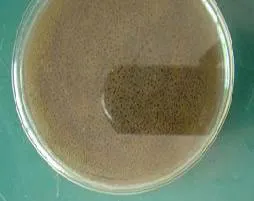
- TEMPERATURE:
Bacteria are highly sensitive to temperature fluctuations. Apart from growth and development, temperature plays a vital role in the biochemical processes carried out by the bacterial cell.
MESOPHILES are the ones which grow well in the temperature range of 25 to 35 degree centigrade. These constitute the bulk of the coffee soil bacteria. For most part of the year the temperature profile in the coffee mountain falls in this range. Some scientists have further divided mesophiles as
OIKOPHILIC; Organisms whose optimum temperature is around 20 degree centigrade.
SOMATOPHILIC; Organisms whose optimum temperature is about 37 degree centigrade.
PSYCHROPHYLES are bacteria that love cold and grow at temperatures below 20 degree centigrade.
THERMOPHILES are temperature loving bacteria and grow best in the temperature range of 45 to 65 degree centigrade. These bacteria are active in compost pits.
- ORGANIC MATTER:
The population of bacteria is directly related to the organic matter content of the soil. Due to periodic leaf shedding and availability of huge quantities of carbonaceous materials on the floor of the coffee forest, the bacterial numbers is the largest. Also the coffee farmers incorporate green manures, compost and biomass from time to time which act as stimulants for the growth and proliferation of bacteria. - ACIDITY:
The optimum pH for the growth of bacteria is NEUTRAL pH. Coffee farmers need to keep the hydrogen ion concentration of their soils close to neutral because in highly alkaline or highly acidic conditions the growth and multiplication of bacteria is inhibited. In general in heavy rainfall areas receiving 100 inches and more it is advisable to apply lime or dolomite once every two years and in moderate rainfall regions, once every four years. This practice will not only increase the bacterial numbers but will also enable the coffee bush to take up inorganic nutrients in a more efficient way.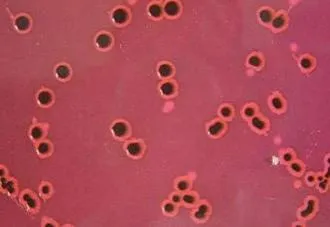
ACIDOPHILIC BACTERIA: Bacteria capable of growth in extremely low Ph
ALKALOPHILIC BACTERIA: Bacteria capable of growth in extremely alkaline soils (p H 10.5)
HALOPHILIC BACTERIA: Bacteria capable of tolerating high salt concentrations.
XEROPHILIC BACTERIA: Bacteria capable of growth in dry habitats. - INORGANIC NUTRIENTS:
Application of fertilizers and chemicals greatly affects the bacterial population. Coffee farmer’s world wide use ammonium fertilizers as the bulk of fertilizer application. Coffee farmers do not realize that ammonium fertilizers tend to lower the soil pH resulting in acidity due to the microbial oxidation of ammonium to nitric acid. More than the effect of fertilizer, it is the acidity which suppresses the bacterial population. This problem can be easily overcome by split applications spread out over a two week period. More importantly, the application of fertilizer should be carried out when the soil moisture is optimum. It is a proven fact that small amounts of inorganic fertilizers supply the needs of the bacterial community in the form of inorganic nutrients.
- FARM PRACTICES:
Farm practices also exert direct and indirect biological effects on the coffee farm. Periodic soil disturbance will affect the bacterial population. Addition of organic manures from time to time and incorporating legumes into the soil with proper carbon nitrogen ratio accelerates the build up of beneficial micro flora. However, if soil hardens up over a period of time, then it will have an adverse effect on the bacterial numbers.
NUTRITIONAL REQUIREMENTS OF BACTERIA:
MACRONUTRIENTS:
Carbohydrarates, Proteins, Lipids, Nucleic Acids. Carbon requirement is the greatest, followed by nitrogen, phosphorus and sulphur. Potassium, sodium, calcium and magnesium are also required in substantial quantities.
MICRONUTRIENTS:
Cobalt, iron, zinc, copper, molybdenum, manganese.
Certain bacteria require specific organic compounds that they are unable to synthesize from simple compounds. Hence they require GROWTH FACTORS classified into one of the following groups.
AMINO ACIDS
PURINES & PYRIMIDINES
VITAMINS.
The dominant groups of bacteria are the heterotrophs but a few genera have photo chromatic pigments enabling them to have photoautotrophic nutrition.
Two main classes of bacteria are the
HETEROTROPHS OR CHEMOORGANOTROPHIC: Bacteria which require preformed an organic nutrient which serves as a source of energy and carbon.

AUTOTROPHIC OR LITHOTROPHIC: Bacteria which obtain their energy from sunlight or by the oxidation of inorganic compounds and their carbon by the assimilation of carbon dioxide.
Autotrophs are further classified as PHOTOAUTOTROPHS OR PHOTOLITHOTROPHS; where energy is derived from sunlight and CHEMOAUTOTROPHS OR CHEMOLITHOTROPHS which obtain their energy from the oxidation of inorganic materials.
SPECIALISED BACTERIAL CELLS:
ENDOSPORES:
Bacterial communities have developed their own specialized skills to survive the hardships of nature. At times it involves a constant battle where it is not only the survival of the fittest but survival by way of forming alliances with other biotic communities. It involves constant signal exchange between predators and prey, struggles for dominance, defense of territories and many ways to simply survive by the production of spores and endospores which are tolerant to adverse weather conditions.
These structures are resistant to heat, desiccation, high salt concentrations, cold, osmosis and chemicals, compared to the vegetative cells producing them. Endospores are bodies produced within the cells of a considerable number of bacterial species. Sporulation confers protection to the cell whenever the occasion arises. Because of their low rate of metabolism , endospores can survive for a number of years without a source of nutrients. However, when favorable conditions appear, endospores begin to germinate within a few minutes to form a new vegetative cell.
MOST COMMONLY ENCOUNTERED SOIL BACTERIA:
Belong to the following genera
Aerobacter, Myxobacteria, Bacillus, Pseudomonas, Flavobacterium, Arthrobacter, Achromobacter, Clostridium, Corynebacterium, Mycobacterium, Sarcina, Myxococcus, Archangium, Chondrococcus, Cytophaga, Sporocytophaga, Polyangium.
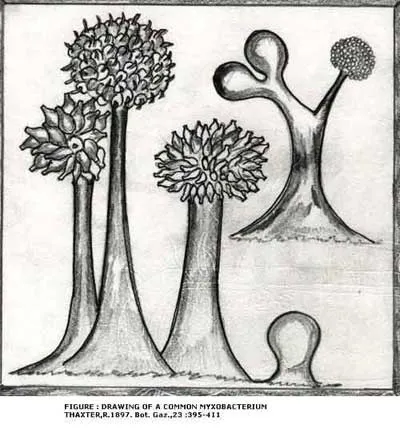
CHEMICAL COMPOSITION OF THE BACTERIAL CELL ON DRY WEIGHT BASIS :
The major constituent is water to the extent of 90 %. The ash content varies. CARBON 45-55% NITROGEN 8-15%. The ash from bacteria may contain PHOSPHORUS 10-50%, POTASSIUM 4-25%, SODIUM 10- 35%, MAGNESIUM 0.1-10%, SILICA 0.5-7.7%, CALCIUM 0.3-14%, CHLORINE 1-44%, and trace amounts of iron. These variations are due to the different bacterial species on the floor of the coffee mountain.
ISOLATION:
We have had the rare opportunity of isolating thousands of species of soil bacteria during our post graduate studies. Our study included soils from various agro climatic regions of Karnataka. Our results had far reaching consequences. We were able to prove that soils with neutral pH harboured the maximum load of nitrogen fixers and phosphate solubilisers. Different soil types had different species of bacteria but most of them were beneficial and acted as important links in various soil transformations.
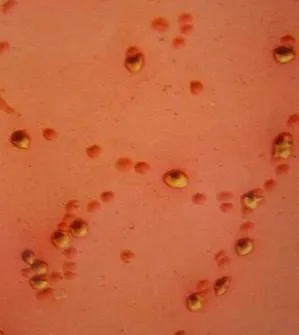
TABLE : ROLE OF BACTERIA IN IMPROVING THE HEALTH OF THE COFFEE PLANTATION.
TYPE OF INTERACTION
PLANT OR SOIL INVOLVEMENT
MICROORGANISMS INVOLVED
AEROBIC & ANAEROBIC
ORGANIC MATTER DECOMPOSITION
SOIL
DIFFERENT GENERA OF BACTERIA
BIOLOGICAL CONTROL
SOIL/PLANT
Bacillus, Pseudomonas species
NITROGEN IMMOBILIZATION
SOIL
DIFFERENT GENERA OF BACTERIA
NITROGEN MINERALIZATION
SOIL
Bacillus, Pseudomonas
PHOSPHATE SOLUBILIZATION
SOIL
Bacillus, Pseudomonas
RHIZOPLANE
ALL BIOTIC PARTNERS-ROOT SURFACE
DIFFERENT GENERA OF BACTERIA
RHIZOSPHERE
ALL BIOTIC PARTNERS-ASSOCIATED WITH ROOTS
DIFFERENT GENERA OF BACTERIA
HISTOSPHERE
ASSOCIATED WITHIN ROOTS
DIFFERENT GENERA OF BACTERIA
PHYLLOSPHERE
ASSOCIATED WITH LEAF SURFACE
DIFFERENT GENERA OF BACTERIA
SYMBIOTIC NITROGEN FIXATION
LEGUMES
Rhizobium
NON-SYMBIOTIC NITROGEN FIXATION
COFFEE,HERBS SHRUBS TREES
Azatobacter, Beijerinckia
NITRIFICATION
SOIL
Nitrosomonas, Nitrobacter
DENITRIFICATION
SOIL
Pseudomonas, Achromobacter
TRANSFORMATION OF VARIOUS ELEMENTS LIKE IRON, COPPER SULPHUR,MANGANESE,
SOIL
Thiobacillus, Ferribacterium, Aerobacter,Clostridium
CONCLUSION
Shade grown Indian coffee plantations have sustained many generations of farmers because of their resilience in overcoming all odds. The secret behind this success is attributed to the microbial inhabitants. Microorganisms cannot be seen by the naked eye, yet they constitute about one quarter of the biomass-the total weight of living organisms in the world. Animals and plants account for the remainder. In the strict sense, more than 98 % of what we describe as waste inside the farm is valuable food for one or the other group of microorganisms. Bacteria recycle these wastes into power packed energy rich nutrients required for the survival of the coffee bush and its partners.
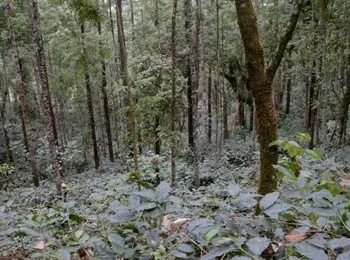
Coffee farmers have an erroneous concept of the role of bacteria in nature. They strongly feel that the majority of bacteria are disease producing. We would like to set the record straight and state that the vast majority of bacteria are not only beneficial but are absolutely essential in building up a healthy coffee farm. Yes, there are a very few bacterial species that are harmful but in a healthy ecosystem they rarely express themselves.
It is very important that the coffee farmer understand the subtle role played by bacteria in the transformation of major elements like nitrogen, sulfur and phosphorus, biodegradation, neutralizing toxic wastes, bio-control agents and a host of other activities. Certain bacteria belonging to the families Thiorhodaceae , Chlorobacteriaceae and Athiorhodaceae contain bacteriochlorophyll and various carotenoids and are also capable of photosynthesis.
Bacterial interactions with the coffee bush and the surrounding flora are known to improve plant growth and productivity. The fertility of the soil is directly dependent on the activity of soil microorganisms. The soil microorganisms mineralize insoluble and indiffusible organic constituents and make them available to plants. The common denominator to assess a healthy soil is the viable number of soil microorganisms.
The shade grown Indian coffee ecosystem is unique in the true sense that it simultaneously achieves the goals of agricultural production in terms of coffee, pepper, citrus, vanilla, areca nut and cardamom production on one hand and the conservation of biodiversity on the other hand. Nothing would be wiser for the world’s coffee producing Nation’s to follow in India’s footsteps and grow coffee under the canopy of trees. There in lies the path to sustainability.
In our humble opinion we strongly feel that only shared prosperity can make the future of this planet secure. At JOE’S SUSTAINABLE FARM we work with ideas that might work or might not work. But in the end analysis, these ideas are the core to the survival of PLANET EARTH.
ACKNOWLEDGEMENT
The authors wish to express their profound gratitude to Professor. H. Harsha Paul . Department of Microbiology, St. Aloysius College, Mangalore-575003, INDIA for providing slides pertaining to various Bacterial cultures.
Mr. Allen J Pais, Coffee Planter, “PROVIDENCE ESTATE”, Siddapur, Coorg, Kodagu. For the detailed drawings.
REFERENCES:
The Fine Art of Composting In Coffee Plantations
Organic Matter Decomposition in Coffee Plantations
Soil Water Conservation in Coffee Plantations
Significance of Microbial Interactions Within Coffee Plantations
Significance of Lime Application in Coffee Plantations
Alexander ,M. 1974 . Microbial Ecology. New York. John Wiley and sons.
Alexander ,M. 1977 . Introduction to soil Microbiology. 2nd edition. New York. John Wiley and sons.
Atlas, R.M. and R. Bartha. 1993. Microbial Ecology : Fundamentals and application. Third edition. Benjamin/Cummings Pub. Co. New York.
Brock. T. D. 1979. Biology of Microorganisms. Third Edition. Englewood Cliffs. Prentice-Hall.
De Witt. W. 1977. Biology of the cell. An Evolutionary Approach. W.B. Saunders Company. Philadelphia , London , Toronto.
Kotpal ,R.L. and N.P. Bali. 2003. Concepts of Ecology. : Environmental and field biology. Vishal Publishing Compamy.India.
Killham. K . 1994. Soil Ecology. Cambridge University Press, Cambridge. England.
Paul. E.A. and Clark. F. E. 1996. Soil Microbiology and Biochemistry. Academic Press.
Pelczar. M.J.Jr; R.D. Reid and E.C.S. Chan. 1977. Microbiology. Fourth Edition. New York. McGraw-Hill.
David B Alexander, 2002. Bacteria and Archaea (chapter 3). In Principles and applications of soil microbiology. Edited by David M Sylvia, J.J. Fuhrmann, Peter G Hartel and David A Zuberer. Prentice Hall. Upper Saddle River, NJ 07458
Paul. E.A. and Clark. F. E. 1996. Soil Microbiology and Biochemistry. Academic Press.
Rangaswami . G and Bagyaraj, D. J. 2001. Agricultural Microbiology. Second edition. Prentice- Hall of India Private Limited. New Delhi.
Salle. A. J. 1983. Fundamentals Principles of Bacteriology. Seventh edition. Tata McGraw Publishing Company LTD. New Delhi.
Subba Rao. N.S. 2002. Soil Microbiology (fourth edition of soil microorganisms and plant growth) Oxford and IBH Publishing CO. PVT. LTD. New Delhi.
Stevenson. F. J. 1982. Humus Chemistry. Wiley-Interscience, New York.
Kelly. D. P. 1978. Microbial Ecology. In K.W.A. Chater and H.J. Somerville (eds ). The oil industry and microbial ecosystems. Heyden and Son , London .
Tilman. D. 1982. Resource Competition and Community Structure. Princeton Unioversity Press, Princeton , NJ.
National Academy of Sciences. 1981. Microbial Processes : Promising Technologies for Developing Countries. N.A.S. Washington, D.C.